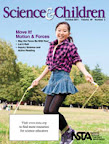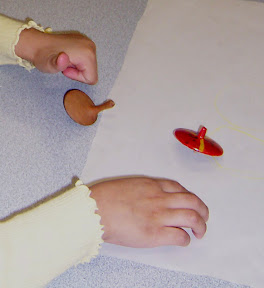Children and motion
By Peggy Ashbrook
Posted on 2011-10-02
 What is in motion in your classroom, in addition to children? Spinning tops are one of the materials I keep available all year long because they can be an independent or collaborative activity, children’s ability to spin them increases as they grow, and spinning tops is an exploration in physical science. The October 2011 Science and Children is all about motion—read to learn more about teaching children about pushes and pulls.
What is in motion in your classroom, in addition to children? Spinning tops are one of the materials I keep available all year long because they can be an independent or collaborative activity, children’s ability to spin them increases as they grow, and spinning tops is an exploration in physical science. The October 2011 Science and Children is all about motion—read to learn more about teaching children about pushes and pulls.

Spinning tops can be part of learning mathematics. Young children can sort tops by size, weight, and shape, then record which top needs the biggest twist-push to begin spinning, and which top spins the longest. The concept of symmetry can be introduced. Children can observe the wobbly motion of a top made purposefully off-balance by the addition of a sticker on one edge or a crown (center post) placed off-center but measuring tiny differences in weight-distribution which affect how well a top can balance is too difficult. After several weeks of child-initiated play with tops, a few four-year-old children were able to predict that a top with a post placed purposefully off-center would not be able to spin. Younger children could not make a prediction or guess and had to try spinning the top. They lost interest when it “didn’t work” and did not investigate it further.
When a top “doesn’t work,” young children may not investigate possible causes such as slowed spinning due to an uneven surface, a loose crown (center post) making the top off balance, or too little strength in the child’s spin. Keep a variety of tops available and support children, before they walk away, with direct instruction on how to grip and turn the top’s crown to make it spin.
 Conversations and group discussion can help children build an understanding of the motion of an object. I have children draw the motion of an object (rather than the object itself) and we use the drawing to talk about the push or pull needed to get the object moving and to make it stop.
Conversations and group discussion can help children build an understanding of the motion of an object. I have children draw the motion of an object (rather than the object itself) and we use the drawing to talk about the push or pull needed to get the object moving and to make it stop.
Older children may be interested in making their own tops using stiff paper and sticks, short pencils, straws, or sections cut from wooden chopsticks. Children will probably need help with the task of balancing the top by making sure the post is in the exact center and the body is a precise circle.
The Spinning Top & Yo-Yo Museum invites you and your class or other group to be part of International Top Spinning Day on Wednesday, October 12, 2011, by spinning a top anytime and anywhere. You can let the world know how many participated by reporting your spins on the museum website. Last year there were more than 20,000 spins!
 Spinning motion can be explored outside on spinning playground equipment. In this setting the children can feel the motion and pulls and pushes as they spin around.
Spinning motion can be explored outside on spinning playground equipment. In this setting the children can feel the motion and pulls and pushes as they spin around. Provide drawing materials as children explore and document the motion of themselves and other objects—swings, wheels on toy cars, slinkys, hula-hoops, and balls in bowls.
The Spinning Top & Yo-Yo Museum notes that tops are known all around the world:
Argentina Trompo, Australia Kiolap, Bulgaria Pumpal, Cambodia Too loo, Denmark Snurretop, Ghana Ate, Greece Sbora, Iceland
Skopparahringla, India Lattoo, Japan Koma, Korea Pang-lh, Mexico Trompo or
Pirinola, New Zealand Potakas, Puerto Rico Chobita, Russia Volchok, Sri Lanka
Pamper, Switzerland Spielbreisel or Pfurri, Taiwan Gan Leh, Turkey Topac, United
States Top, and Venezuela Trompo or Zaranda
What name do you call these toys that teach science concepts?
Peggy
Disclaimer: The views expressed in this blog post are those of the author(s) and do not necessarily reflect the official position of the National Science Teaching Association (NSTA).


